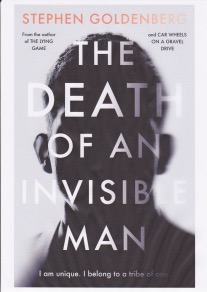My novel has now been published as a paperback and can be ordered from my publisher, Matador, from any online bookseller or from your local bookshop.
Author: stephengoldenbergauthor
My new novel, The Death of an Invisible Man, has just been published as a paperback and an ebook.
The paperback can be ordered from my my publisher’s website – Matador publications. The ebook is available to download for free from Amazon Kindle from Tuesday 1st September to Saturday 5th September.
I would only ask that, if you do go for the free download, you could leave a review of the novel on Amazon.

The Death of an Invisible Man
If you want to know more about how I came to create the character of Hare Yehuda Felatu in my new novel, see my video on You Tube where I explain how he came about.
Just go to Youtube and type Steve Goldenberg in the search box.
The draft cover fro my new novel The Death of an Invisible Man.
Thé Death of an Invisible Man
My latest crime novel The Death of an Invisible Man is at the typeset proofs stage and, Coronavirus allowing, should be published in the next few months. My publisher has scheduled its release date for the media and book industry for September.
Eggheads
My team, The Story Ministers, are appearing on Eggheads on Monday 29th April on BBC2 at 6 o’clock.
Upcoming Events
Friday 21st April – English Library at Villefranche-de-Rouergue (Hotel Les Fleurines), France
5.30 – 8.00 (with aperitifs)
I will giving a presentation and readings from my novel Car Wheels on a Gravel Drive alongside writer of historical fiction, Tracey Warr.
Saturday 27th May – LibraryLit at Parisot Library, France
10.30 – 12.00 a.m. (followed by aperitifs)
I am giving a talk on crime writing entitled Plot or Character – which comes first? Among other things, I will be considering,
- creating characters from scratch.
- unreliable narrators.
- when characters start to talk to the writer.
Autobiography of an Invisible Man
The novel I’m working on is provisionally titled ‘The Autobiography of an Invisible Man’. This is the Wikipedia page for the invisible man of the title.
Harry Felatu (a.k.a. Hare Yehuda Felatu) born in 1930 in Bloomsbury London, he was a mysterious figure on the fringes of the bohemian Soho art and literary scene of the 1950s and 1960s, a friend of Francis Bacon and an occasional model for his paintings.
Early Years
His father was the New Zealand Maori rugby all-black, Maka Felatu, and his mother was Sarah Weinstein, the daughter of a wealthy Welsh Jewish family. his parents met when his father was on a rugby tour of the UK. His parents split up shortly after his birth. His father returned to New Zealand and Harry was brought up by his single parent mother. He was educated at the Royal Grammar School High Wycombe but left school early and went to live and work in London, taking up a variety of occupations including night club bouncer and racing tipster.
The Soho Years
At six feet six inches tall and weighing two hundred and fifty pounds, he was a conspicuous figure who soon attracted attention when he began to frequent the Soho drinking dens in the early 1950s. He was befriended by the painter, Francis Bacon, and became both his model and his bodyguard. Apart from his appearance in two of Bacon’s better known paintings ‘Polynesian Man in a Headscarf’ and ‘Reclining Male Nude’, little is known about him until, in 1956, he wrote a novel ‘An Angel in the City of Sin’. Set in Soho, it was a kind of female rake’s progress, also described by one critic as Fanny Hill for the twentieth century. it tells the picaresque story of Mary Cregan, a young Irish girl coming to London as an au pair, who slowly descends into a life of debauchery leading to her premature death. With its realistic depictions of Soho’s lower depths mixed with elements of drug-infused fantasy and mysticism, some critics later championed it as a precursor of magical realism. Because of its explicit sexual content, no British publisher would touch it but it was published by the Olympia Press in Paris and gained some notoriety although few sales.
The Later Years
His novel was republished in 1968 as a Panther paperback and, this time, found a cult following within the London hippy scene. This brief period in the spotlight culminated in an appearance on an early edition of Late Night Lineup on BBC 2 where he was interviewed live about his novel by a young Joan Bakewell. No tape of the interview survives but it is rumoured that Felatu was drunk and it was brought to an abrupt close.
For most of his life, Felatu remained a figure in the Soho shadows – a hanger-on, an imposing ornament. It is rumoured that he was also involved on the fringes of the criminal underworld, possibly as an occasional henchman of the Krays, but there is no firm evidence for this. Little is known about his life since other than, like many in his bohemian circle, he drifted into alcoholism and poverty.
Tour de France passes Parisot

Yesterday the Tour de France passed through our commune. We sat by the roadside outside Parisot for 3 hours with some friends and a picnic. Then, of course, it flashes by in 5 seconds. Still, it was an experience – especially the hour long train of advertising vehicles showering us with tat.
Car Wheels Chapters 1-3
Car Wheels on a Gravel Drive Chaps. 1-3
